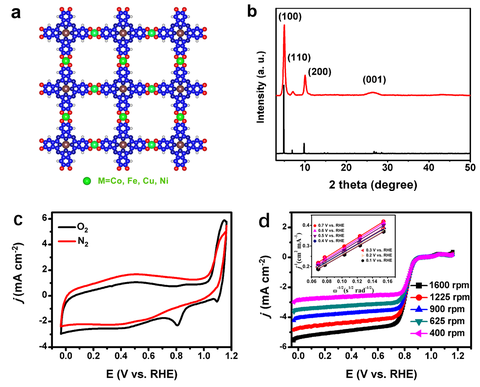Jul 11, 2019
Layered Two-Dimensional Conjugated Metal-Organic Framework as Highly Efficient Electrocatalyst for Oxygen Reduction Reaction
Metal-organic frameworks (MOFs), have been rising as a fascinating family of electrocatalysts with both homogeneous and heterogeneous advantages: the well-defined structures and readily accessible active sites can be tuned at the molecular level to improve the catalytic performance and also enable the MOFs to serve as model systems for fundamental understanding of catalytic mechanism. However, great challenges still plagued on the conventional MOFs including electrical insulators and blockage of metal centers by organic ligands, resulting in their inferior activity (half-wave potential E1/2 <0.8 V vs RHE) and dramatically limit their broader applications in electrocatalysis. Pyrolysis of MOFs into metal- and heteroatom-doped porous carbons has been widely demonstrated to improve the catalytic activity. However, this method has to sacrifice the well-defined molecular active sites.
In order to address these challenges, researchers from Technical University of Dresden (Chair for Molecular Functional Materials) and collaborators have developed a copper-phthalocyanine-based 2D conjugated MOF with square planar cobalt-bis(dihydroxy) complexes (Co-O4) as linkages (PcCu-O8-Co), which is atomically ordered, planar metal-organic networks along 2D directions with fully in-plane π-delocalization and weak out-plane π-π stacking. This 2D MOFs shows unique 2D features as well as improved electron transfer capacity and high utilization of exposed active sites apart from the inherited advantages of traditional MOFs. PcCu-O8-Co 2D MOF mixed with carbon nanotubes exhibits excellent electrocatalytic ORR activity (E1/2=0.83 V vs. RHE, n=3.93, and jL=5.3 mA cm-2) in alkaline media, which is the record value among the reported intrinsic MOF electrocatalysts. Supported by in-situ Raman spectro-electrochemistry and theoretical modelling as well as contrast catalytic tests, we identified the cobalt nodes as ORR active sites. Furthermore, when employed as cathode electrocatalyst for zinc-air battery, PcCu-O8-Co delivers a maximum power density of 94 mW cm-2, outperforming the state-of-the-art Pt/C (78.3 mW cm-2).
Reference:
Haixia Zhong, Khoa Hoang Ly, Mingchao Wang, Yulia Krupskaya, Xiaocang Han, Jichao Zhang, Jian Zhang, Vladislav Kataev, Bernd Büchner, Inez M. Weidinger, Stefan Kaskel, Pan Liu, Mingwei Chen, Renhao Dong* & Xinliang Feng*, A Phthalocyanine‐Based Layered Two‐Dimensional Conjugated Metal–Organic Framework as a Highly Efficient Electrocatalyst for the Oxygen Reduction Reaction. Angew. Chem. Int. Ed. 2019, doi.org/10.1002/ange.201907002..
This work is financially supported from EU Graphene Flagship, ERC T2DCP, Coordination Networks: Building Blocks for Functional Systems (SPP 1928, COORNET), as well as the German Science Council and Center of Advancing Electronics Dresden (cfaed). H.X.Z. gratefully acknowledges funding from China Scholarship Council and Deutscher Akademischer Austauschdienst German Academic Exchange Service, the Alexander von Humboldt Foundation. I.M.W. acknowledges the Cluster of Excellence UniSysCat. We acknowledge Dresden Center for Nanoanalysis (DCN) at TUD, Dr. Petr Formanek (Leibniz Institute for Polymer Research, IPF, Dresden) for the use of facilities. We also like to appreciate the helpful discussion from Dr. Zhongquan Liao, Mr. Zhiyong Wang and Dr. Chongqing Yang. We thank the beamline BL14W1 and BL15U1 of the Shanghai Synchrotron Radiation Facility for the XAFS measurements.

